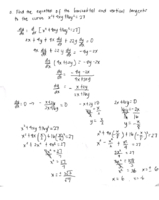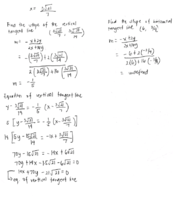You are using an out of date browser. It may not display this or other websites correctly.
You should upgrade or use an alternative browser.
You should upgrade or use an alternative browser.
Calculus
- Thread starter Kaikai28
- Start date
Dr.Peterson
Elite Member
- Joined
- Nov 12, 2017
- Messages
- 16,873
If your difficulty is in finding the derivative, do it implicitly. Then, of course, you'll be looking for where it is zero or undefined.Hello. How to find the equation of the horizontal and vertical tangents to the curve x^2+4xy+16y^2=27 I really need help. Pls
Please show us your work, so we can see what help you need. That's a lot more efficient than trying to guess what to focus on.
Dr.Peterson
Elite Member
- Joined
- Nov 12, 2017
- Messages
- 16,873
Thanks. That's exactly what we ask you to do:I have not finished answering. This is my answer but I think its wrong.
Posting Guidelines (Summary)
Welcome to our tutoring boards! :) This page summarizes main points from our posting guidelines. As our name implies, we provide math help (primarily to students with homework). We do not generally post immediate answers or step-by-step solutions. We don't do your homework. We prefer to help...
www.freemathhelp.com
"Show work that you've already done (even if you think it's wrong), and try to explain why you're stuck."
There's a lot of good work here. I do see a couple problem points.
One is that you write dy/dx = 0, but then find both where the numerator is 0 (good) and where the denominator is zero (that's an undefined derivative, not zero). So you've failed to distinguish the two kinds of points.
Then you took a solution that really has a horizontal tangent, called it vertical, and found the slope to be -1/5, which would be neither! Clearly that m should have been 0; you have a sign error.
Then you took a solution where the derivative is undefined and called it horizontal rather than vertical. You correctly found the derivative to be undefined; the next step will be to write the equation of that vertical line. What does the equation of a vertical line look like?
So the errors are small, though they look huge because of failing to pay attention to what horizontal and vertical mean.
Thanks. That's exactly what we ask you to do:
Posting Guidelines (Summary)
Welcome to our tutoring boards! :) This page summarizes main points from our posting guidelines. As our name implies, we provide math help (primarily to students with homework). We do not generally post immediate answers or step-by-step solutions. We don't do your homework. We prefer to help...www.freemathhelp.com"Show work that you've already done (even if you think it's wrong), and try to explain why you're stuck."
There's a lot of good work here. I do see a couple problem points.
One is that you write dy/dx = 0, but then find both where the numerator is 0 (good) and where the denominator is zero (that's an undefined derivative, not zero). So you've failed to distinguish the two kinds of points.
Then you took a solution that really has a horizontal tangent, called it vertical, and found the slope to be -1/5, which would be neither! Clearly that m should have been 0; you have a sign error.
Then you took a solution where the derivative is undefined and called it horizontal rather than vertical. You correctly found the derivative to be undefined; the next step will be to write the equation of that vertical line. What does the equation of a vertical line look like?
So the errors are small, though they look huge because of failing to pay attention to what horizontal and vertical mean.
THANK YOU SO MUCH FOR YOUR HELP!Thanks. That's exactly what we ask you to do:
Posting Guidelines (Summary)
Welcome to our tutoring boards! :) This page summarizes main points from our posting guidelines. As our name implies, we provide math help (primarily to students with homework). We do not generally post immediate answers or step-by-step solutions. We don't do your homework. We prefer to help...www.freemathhelp.com"Show work that you've already done (even if you think it's wrong), and try to explain why you're stuck."
There's a lot of good work here. I do see a couple problem points.
One is that you write dy/dx = 0, but then find both where the numerator is 0 (good) and where the denominator is zero (that's an undefined derivative, not zero). So you've failed to distinguish the two kinds of points.
Then you took a solution that really has a horizontal tangent, called it vertical, and found the slope to be -1/5, which would be neither! Clearly that m should have been 0; you have a sign error.
Then you took a solution where the derivative is undefined and called it horizontal rather than vertical. You correctly found the derivative to be undefined; the next step will be to write the equation of that vertical line. What does the equation of a vertical line look like?
So the errors are small, though they look huge because of failing to pay attention to what horizontal and vertical mean.
[MATH]
[QUOTE="Jomo, post: 519227, member: 46610"]
The equation of a horizontal line is always in the form y = k, where k is some number.
The equation of a vertical line is always in the form x = k, where k is some number.
[/QUOTE]
Thanks for your help.
[/MATH]


